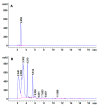Mineralization and Detoxification of the Carcinogenic Azo Dye Congo Red and Real Textile Effluent by a Polyurethane Foam Immobilized Microbial Consortium in an Upflow Column Bioreactor
- PMID: 26086710
- PMCID: PMC4483738
- DOI: 10.3390/ijerph120606894
Mineralization and Detoxification of the Carcinogenic Azo Dye Congo Red and Real Textile Effluent by a Polyurethane Foam Immobilized Microbial Consortium in an Upflow Column Bioreactor
Abstract
A microbial consortium that is able to grow in wheat bran (WB) medium and decolorize the carcinogenic azo dye Congo red (CR) was developed. The microbial consortium was immobilized on polyurethane foam (PUF). Batch studies with the PUF-immobilized microbial consortium showed complete removal of CR dye (100 mg·L-1) within 12 h at pH 7.5 and temperature 30 ± 0.2 °C under microaerophilic conditions. Additionally, 92% American Dye Manufactureing Institute (ADMI) removal for real textile effluent (RTE, 50%) was also observed within 20 h under the same conditions. An upflow column reactor containing PUF-immobilized microbial consortium achieved 99% CR dye (100 mg·L-1) and 92% ADMI removal of RTE (50%) at 35 and 20 mL·h-l flow rates, respectively. Consequent reduction in TOC (83 and 79%), COD (85 and 83%) and BOD (79 and 78%) of CR dye and RTE were also observed, which suggested mineralization. The decolorization process was traced to be enzymatic as treated samples showed significant induction of oxidoreductive enzymes. The proposed biodegradation pathway of the dye revealed the formation of lower molecular weight compounds. Toxicity studies with a plant bioassay and acute tests indicated that the PUF-immobilized microbial consortium favors detoxification of the dye and textile effluents.
Keywords: Congo red; column bioreactor; decolorization; immobilization; microbial consortium; mineralization.
Figures








References
-
- Saratale R.G., Saratale G.D., Chang J.S., Govindwar S.P. Bacterial decolorization and degradation of azo dyes: A review. J. Taiwan Inst. Chem. Eng. 2011;42:138–157. doi: 10.1016/j.jtice.2010.06.006. - DOI
-
- Linda V., Gutierrez G., Gonzalez-Alatorre G., Escamilla-Silva E. Proposed pathways for the reduction of reactive azo dye in an anaerobic fixed bed reactor. World J. Microbiol. Biotechnol. 2009;25:415–426.
MeSH terms
Substances
LinkOut - more resources
Full Text Sources
Other Literature Sources

